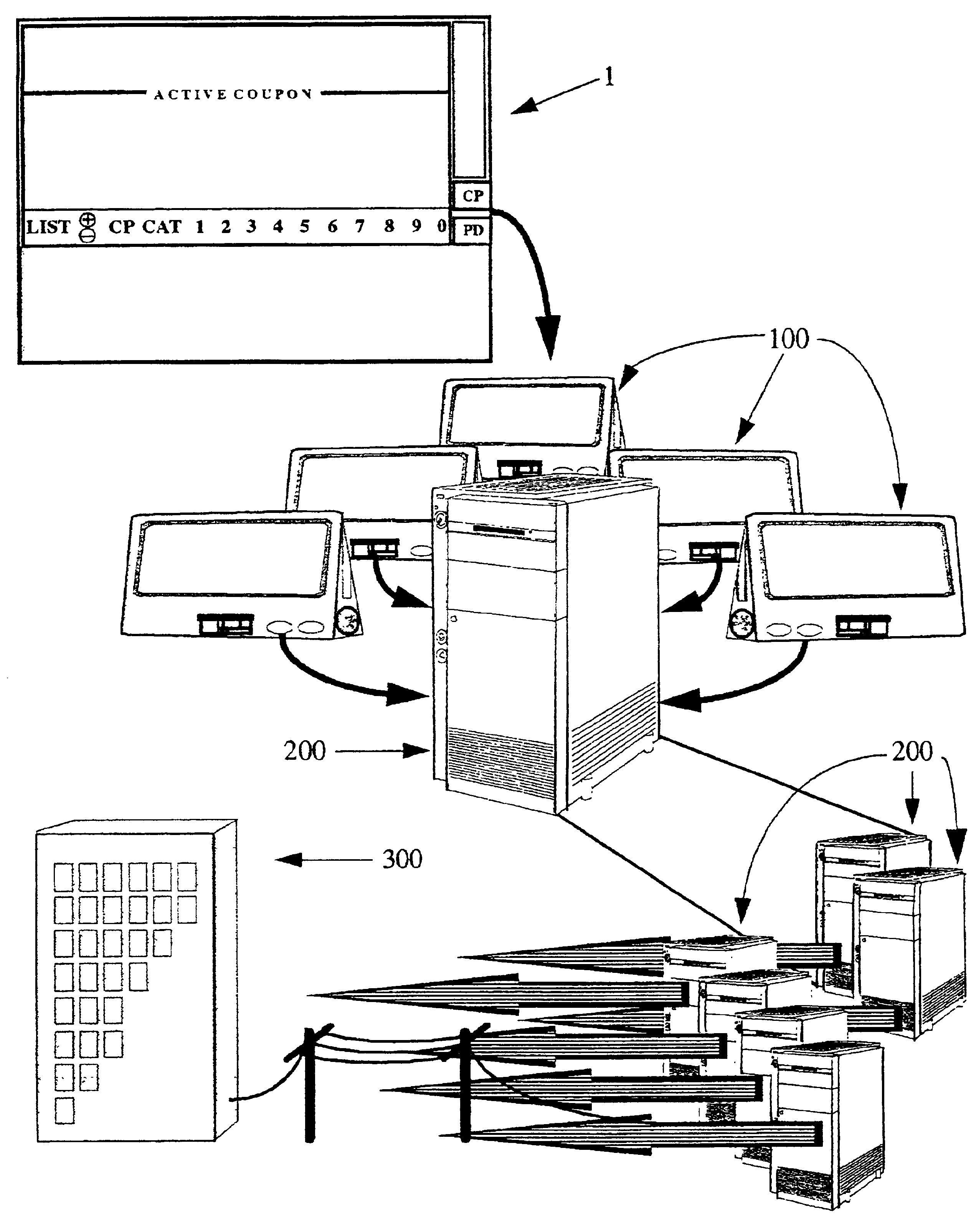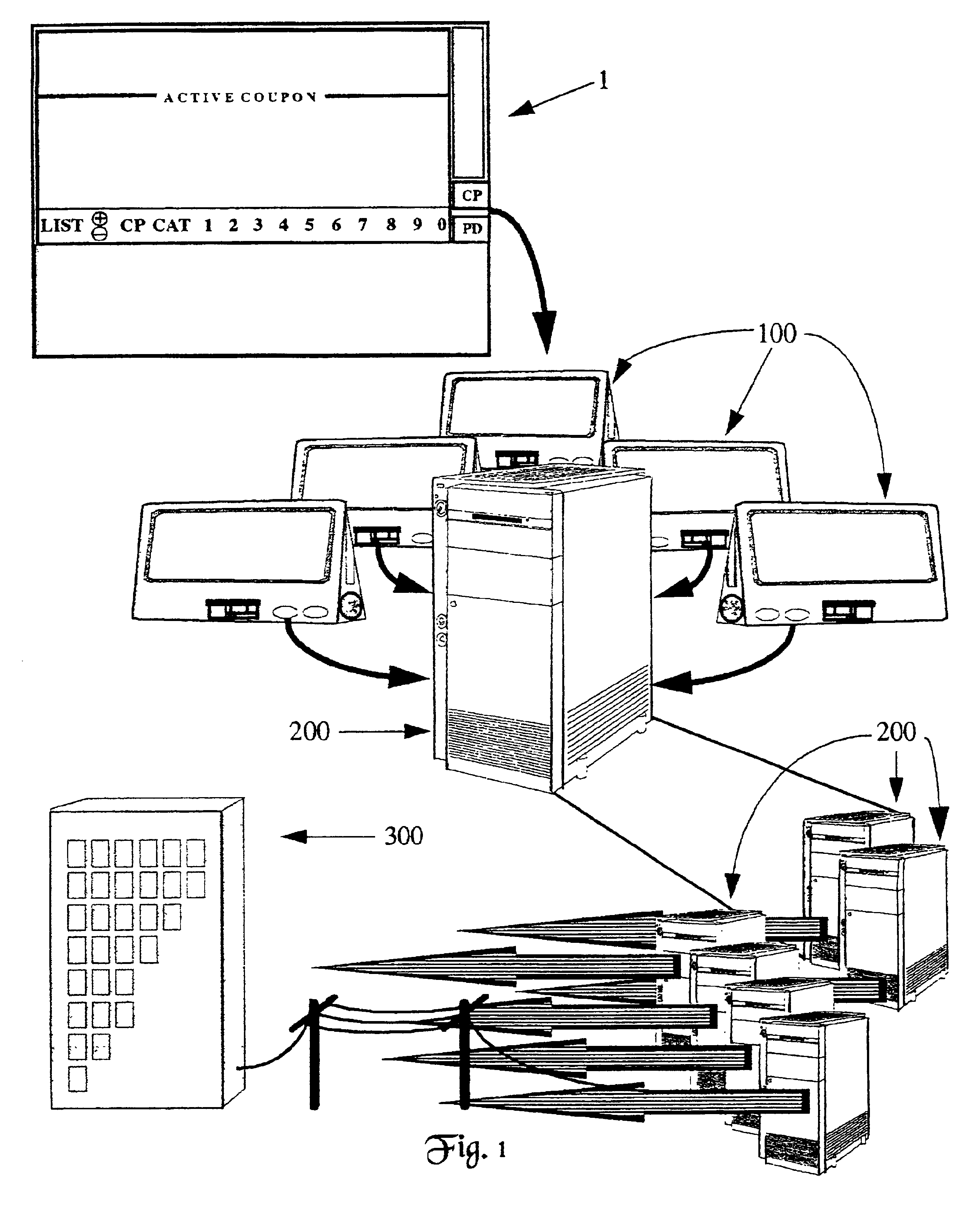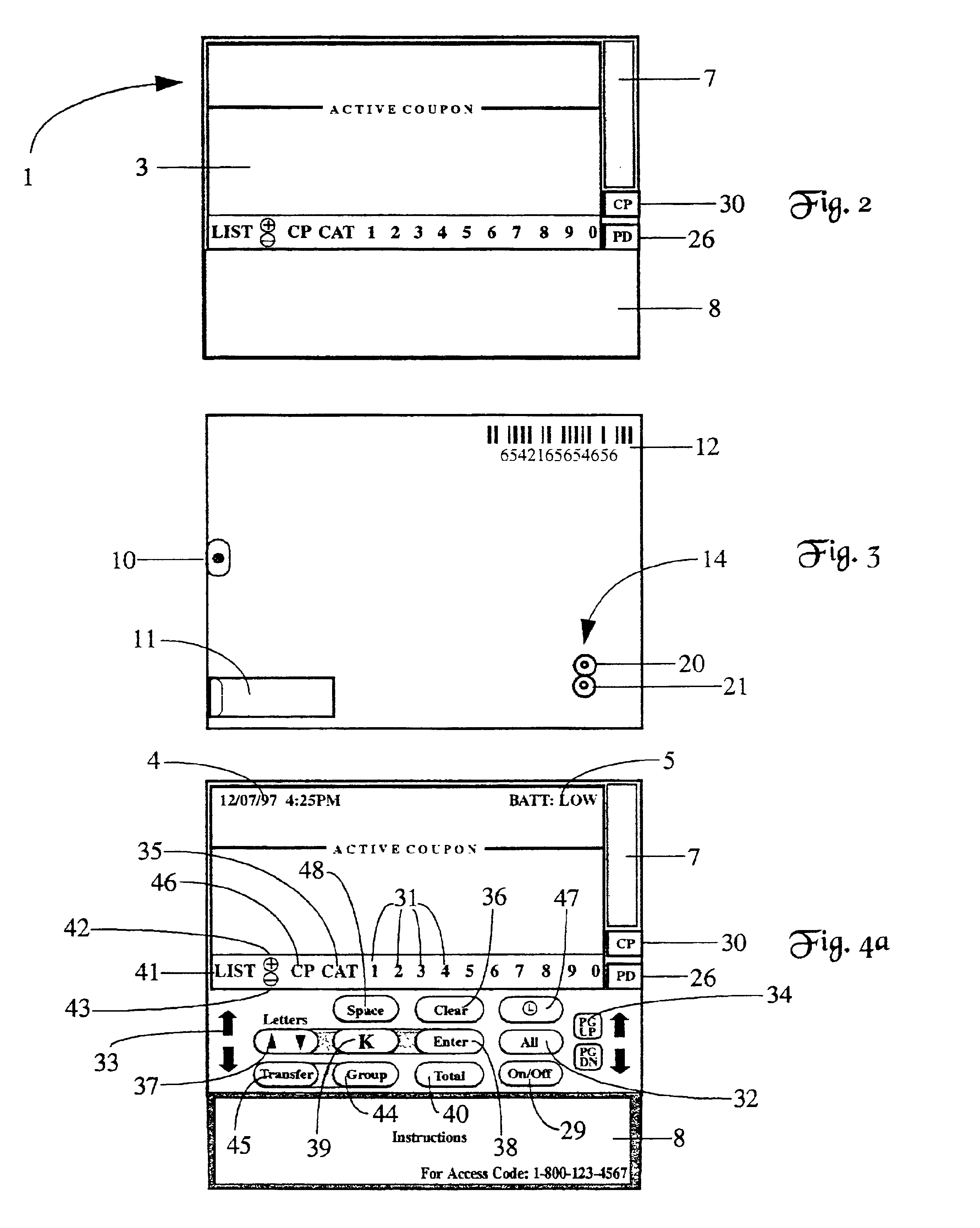[0008]The present invention comprises a system for electronically collecting, carrying and redeeming coupons which eliminates the many disadvantages consumers, retailers and manufacturers face when shepherding paper coupons through the redemption process. One component of the system is a portable coupon card which will include, among other features discussed more specifically in the detailed description, a bar code
scanner, a memory means, a display screen, and a communications port, all controlled by a
microprocessor and operational keys. The bar code
scanner allows users to scan into the memory means the bar codes on coupons wherever a user may find the coupons. The display screen allows the user to view information concerning each coupon such as what product is represented by the coupon and the discount provided by the coupon. The microprocessor and operational keys allow the user to initiate the scanning of bar codes and arrange into various categories the coupons in the memory of coupon card, while the communications port will allow the transfer of coupon bar codes to a periphery device, another component of the system.
[0010]Another component of the present invention is a periphery device which will be positioned along the cash register stand in a retail store such as a supermarket. The periphery device will have an
insertion port for receiving the coupon card, multiple communications ports allowing the periphery device to receive into a memory means
electronic data from both the coupon card and the cash register, a microprocessor, operational keys and two display screens which allow the cashier and
consumer to view the transactions taking place in the periphery device. During checkout, a
consumer will insert the coupon card into the periphery device and the periphery device will read coupon bar codes from the coupon card and the periphery device will also receive data from the cash register indicating what products were purchased by the
consumer. The periphery device will compare the data received from the cash register and the bar codes on the coupon card to determine what coupons are redeemable against the consumer's purchases. A
list of redeemable coupons will then be displayed on the periphery device. Using the operational keys on the periphery device, the cashier may take care of any concerns the consumer has about the
list of redeemable coupons. For example, the cashier may search the coupons on the coupon card for a coupon the consumer believes was mistakenly not included in the list of redeemed coupons. When that coupon is found, the periphery device will display a marker on the display screens indicating why the coupon was not redeemed. In the appropriate situation, the cashier may use an “override” operational key to include a coupon on the list of redeemed coupons even though that coupon is not technically appropriate for redemption. Other operational keys discussed herein will allow additional functions to be carried out by the periphery device. When a final list of redeemed coupons is agreed upon, the list will be transferred to the cash register for crediting against the consumer's purchases. Additionally, the periphery device will remove the coupons which were redeemed from the memory of the coupon card. Because all questions about individual coupons are handled efficiently at the same time before the redeemed coupons are sent to the cash register, the present invention greatly increases the speed of the coupon redemption process as compared to the prior art's method of individual, paper coupon
processing because all overriding functions are performed before the bar codes are passed to the cash register, eliminating transaction interruption. As discussed more fully below, the periphery device, among other functions, will also be able to transmit data on future manufacturer coupons to the coupon card or place directly onto the coupon card coupons which will be ready for immediate use.
[0013]The present invention further provides a method of altering the value of coupons once the coupon has been entered into the coupon card. The clearinghouse
database will send information to the servers indicating that when a coupon card is entered into the periphery device, the periphery device should search the coupon card for the particular coupon whose value is to be altered. That coupon will then be replaced with a new coupon for the same item having a different value. This process can be repeated several times with ever increasing values for the coupon if desired by the product manufacturer. Therefore, unlike paper coupons which are static, coupons which can change in value may be used to restimulate a consumer each time the value of the coupon increases. Another method of the present invention will use the periphery,
server, and
database to make manufacturer rebates immediately available to consumers. In this method, the information on manufacturer rebates is supplied to the clearinghouse
database and thereby made available to the periphery devices of the various stores. When the periphery device reads the products purchased from the cash register, the periphery device will indicate if there is a manufacturer rebate existing for any of the purchased products. This paperless rebate system allows the consumer to instantly receive credit for rebates, while quickly and efficiently supplying the manufacturer with both the
demographic data and stimulation power the rebate is intended to provide.
[0015]Another apparatus of the present invention for electronically distributing coupons is an adapter allowing the coupon card to receive coupons from
the Internet via the disk drive of a conventional computer. While it is known to receive coupons from
the Internet, conventional systems transfer the coupon information to a printer to produce a printed paper coupon. This, of course, has all the disadvantages of paper coupons previously discussed. The adapter of the present invention avoids any need for paper by transmitting the coupon directly to the coupon card. The adapter will a have a
insertion port for receiving the coupon card, a communications port, and a microprocessor. The adapter will also include a magnetic head for receiving
electronic data from a corresponding magnetic head in the disk drive and the adapter will be sized to fit into the disk drive similar to a conventional “floppy” disk. When the computer receives electronic coupons from
the Internet, the coupons will be sent to the computer's disk drive. The coupon card will have been positioned in the adapter's
insertion port and the adapter placed in the computer's disk drive. The magnetic head in the disk drive will transmit the coupon information to the magnetic head of the adapter. The adapter will then transmit the coupon information to the coupon card through the adapter's communications port.
 Login to View More
Login to View More  Login to View More
Login to View More 


